It never fails. There isn’t one type of snake that doesn’t have some kind of misconception or urban legend attached to it. Perhaps no other species of snake causes as much chaos and hurt feelings as the coralsnake, and “the rhyme” that is forever attached to them.
The Coralsnakes
The coralsnakes covered in this article are the 65 recognized species of New World coralsnakes in three genera (Leptomicrurus, Micruroides, and Micrurus), most notably the three U.S. species ; Eastern Coralsnake (Micrurus fulvius), Texas Coralsnake (Micrurus tener), and Arizona Coralsnake (Micruroides euryxanthus). These three snakes are clad in red, yellow, and black rings (sometimes red, white, and black in the Arizona coral). Coralsnakes are venomous Elapids and many species are considered medically significant.
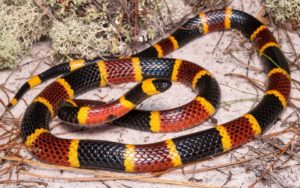
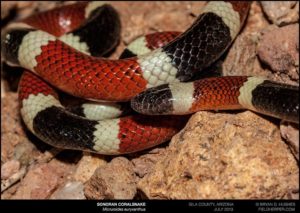
Coralsnakes have powerful neurotoxic venom that is often mixed with other venom types. This venom alters the normal activity of the nervous system in such a way as to cause permanent or irreversible damage to nervous tissue. Most coralsnakes are secretive and rarely seen, spending much of their time under loose soil and leaf litter where they hunt other reptiles. Bites from these snakes are generally uncommon due to their secretive nature and reluctance to bite. This being said, these snakes should never be handled and a coralsnake bite is a serious medical emergency and prompt treatment is the only course of action that should be taken.
The Rhyme
Now that we have a little background on coralsnakes we can move on to the fun part. Somewhere along the way, someone came up with a rhyme to differentiate venomous coralsnakes and non-venomous species which appear similar, such as the Scarlet Kingsnake (Lampropeltis elapsoides). The rhyme goes “Red touches black, venom lack. Red touches yellow, kill a fellow”. There are a few other variation of this rhyme, but the idea behind it is to identify these snakes by the color of their banding. Several species of non-venomous snake in the U.S. have alternating red, black, and yellow banding and have historically caused confusion.
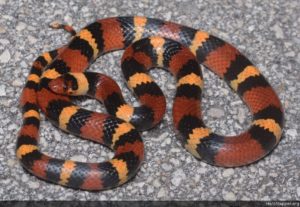
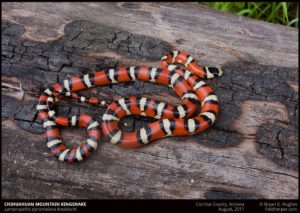
The Controversy
In this section we will cover some of the controversies surrounding the rhyme, and I will then summarize everything at the end of this article. “The Rhyme” has been ingrained into popular lore for several decades to the point where it has become the “end all” identification technique for many people. The truth is that, in the United States, the rhyme is not as bad as some people would have you believe. At a quick glance it can be used as a tool to separate a harmless species from a potentially venomous coralsnake. Indeed, for the most part, the red and black DO touch on the non-venomous species, and the red and yellow DO touch on the venomous coralsnakes.
The first controversy is that sometimes (rarely) a snake will be found that does not look like the field guide photo. These snakes are called “aberrant” and they often have markings and colors that are different – sometimes extremely different – from the “normal” version of the species.
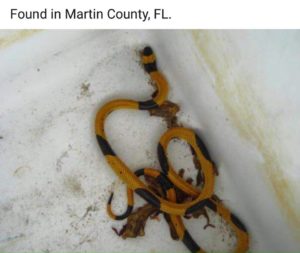
The argument is that the rhyme is unreliable because of the chance of coming across one of these aberrant individuals, confusing the average person, and possibly resulting in a venomous bite.
The second controversy is the existence of a snake native to the southwestern U.S., the Shovel-nosed Snakes (Chionactis sp.) These small, harmless snakes do have red and yellow bands touching, which may cause confusion and could result in these snakes being killed.
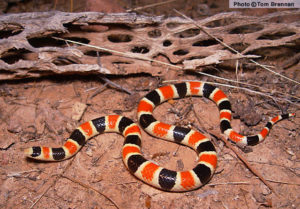
The third controversy is that the rhyme is often misquoted and mixed up which could cause someone to mistake a coralsnake for a non-venomous species.
The fourth, most dangerous, and 100% accurate argument is that the rhyme is only reliable when in reference to coralsnakes native to the United States. Once we enter Mexico and down through South America, we encounter dozens of coralsnake species which do not follow any rules or rhymes. To add to the confusion there are also dozens of coralsnake “mimics” in Central and South America and Mexico. These range from non-venomous species to rear-fanged and venomous species.
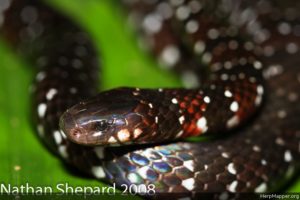
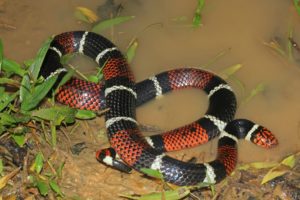
The Final Word
Somewhere along the line the rhyme has been taken out of context and is being used as a stand-alone technique for identifying the snakes covered in this article. That, in my opinion, is the main problem. Accurately identifying snakes takes time and experience, and no one should be relying on ONE technique to identify snakes (such as the rhyme) ; instead, we must use several techniques and features as a WHOLE to identify snakes, such as body shape, head shape, pattern, behavior, and location. Perhaps most important, if you are uncertain about the identity of a snake, simply leave it alone and maintain a safe distance. This will keep you safe in the slim chance you have encountered an aberrant coralsnake.
Coralsnakes are shy and are not looking to bite or attack humans! They just want to be left alone like any other wild animal and can be safely observed as they go about their business.
Here are the main bullet points to keep in mind!
- The rhyme can be used only in conjunction with other features to identify snakes.
- The rhyme is only to be used in reference to coralsnakes native to the United States.
- When in doubt do not touch or handle a snake you cannot reliably identify!
Thanks for reading!